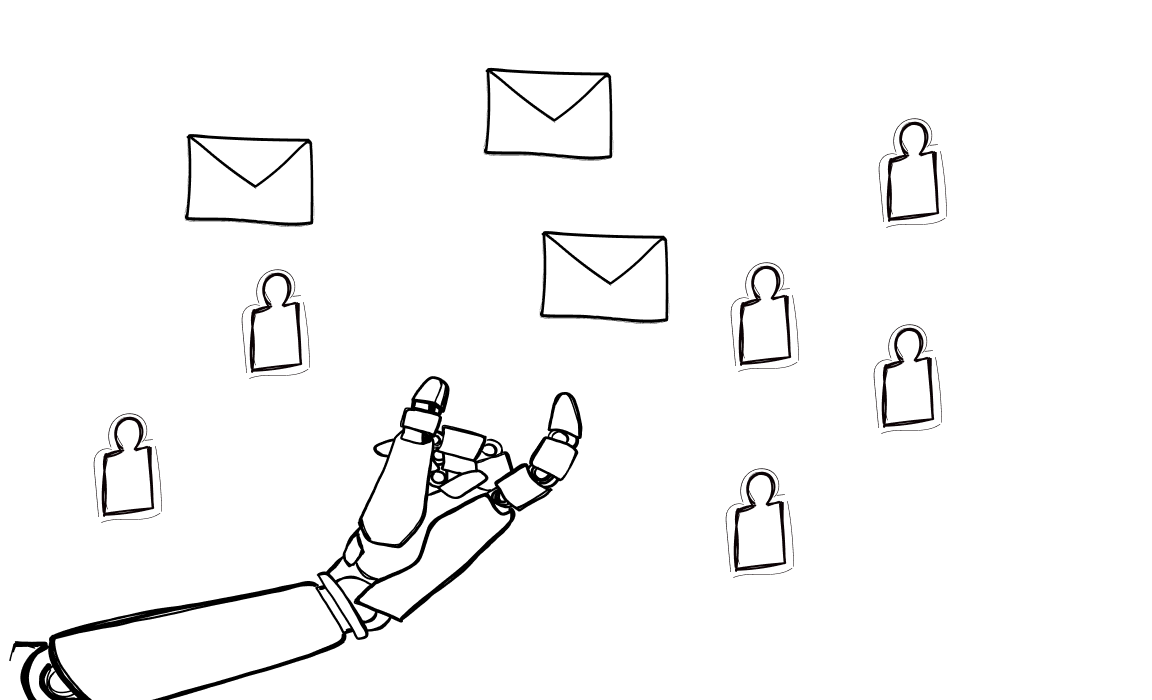If outbound emails are your battlefield, A/B testing is the best reconnaissance tool you’ve got. It’s not just about open rates—it’s about discovering what actually moves the needle for your unique audience. Below are 11 practical A/B test ideas that go beyond “try a new subject line” (although, yes, you should do that too). Each one is designed to help you drive better replies, book more meetings, and squeeze more value out of every send.
1. Opening line: Make them care in 3 seconds or less
Why test it?
Your first sentence is often all the recipient sees in their inbox preview, and it shapes whether they even bother to open. Instead of a generic opener (“Hope you’re well!”), try contrasting approaches: jump straight to a benefit (“Quick way to double your review rates”) vs. a curiosity trigger (“Saw something surprising on your site…”).
What to try:
- A question addressing a pain point vs. an unexpected stat or observation
- Personal reference to their recent activity vs. a more generic greeting
How to use your findings:
Whichever style wins more opens/replies, double down on it in future campaigns—and consider rewriting your follow-up openers too.
2. Email length: Minimalist punch vs. detailed value
Why test it?
Some people love quick reads—others want enough context to say yes. Don’t just “go short” by default.
What to try:
- A 3-4 line message with a single, direct CTA
- A longer version that provides more details, credibility, and context (like a mini pitch deck in email form)
How to use your findings:
Notice if shorter emails bring more replies but longer ones bring better-qualified leads. Adjust length based on campaign goals: speed for quantity, substance for quality.
3. Call to action: Direct booking vs. conversational ask
Why test it?
Forcing everyone to book a call can be off-putting. Some people want a low-stakes way to respond.
What to try:
- A direct ask with a calendar link (“Book a 15-min call here”)
- A simple, conversational reply request (“Is this even on your radar? Just hit reply and let me know!”)
How to use your findings:
If you see more meetings booked from direct CTAs, keep going. If reply CTAs get more conversations started, build your nurture flow around that lower-friction engagement.
4. Sender name: Real human vs. brand entity
Why test it?
People reply to people, but sometimes a well-known brand carries more credibility—especially in B2B.
What to try:
- Your first name + company (“Anya at SaaSCRM”)
- Company name only (“SaaSCRM Team”)
- Just your first name
How to use your findings:
Keep an eye on open rates, replies, and even spam complaints. For some markets, “human-first” wins trust. For others, the brand is the door-opener.
5. Personalization depth: True 1:1 vs. “Hi {FirstName}”
Why test it?
The world has caught on to fake personalization. True, thoughtful references stand out.
What to try:
- Referencing specific, recent actions (a blog post, press release, or social post)
- Standard mail-merge fields only (name, company, job title)
How to use your findings:
Track not just reply rates, but quality of replies. Deep personalization may bring fewer but more meaningful conversations—use it for your highest-value prospects.
6. Sending time: When does your audience actually check email?
Why test it?
There’s no universal “best time.” Decision makers in retail? Early morning or late night. Tech folks? Maybe post-lunch.
What to try:
- Morning vs. afternoon vs. evening
- Middle of the week vs. Monday/Friday
- Different time zones for global audiences
How to use your findings:
Let the data guide you. Even small changes in send times can mean more emails seen, opened, and answered.
7. Tone of voice: Buttoned-up vs. friendly and informal
Why test it?
Overly formal emails sound like robots. Overly casual emails can come off unprofessional. Your prospects have a preference.
What to try:
- Super professional: “Dear Ms. Jones, I am reaching out to…”
- Breezy and direct: “Hey Sam, quick one for you—”
- Somewhere in the middle
How to use your findings:
Adjust your voice for each industry or persona. Sometimes, a touch of humor or humility builds trust. Other times, buttoned-up gets respect.
8. Offer size: Big ask vs. small step
Why test it?
It’s tempting to push for a meeting right away, but sometimes, asking for something smaller opens the door.
What to try:
- “Let’s jump on a 30-minute call next week.”
- “Is this even relevant for you? If not, just let me know.”
- “Can I send you a short resource first?”
How to use your findings:
See if a lower-commitment CTA brings more first replies—and if you can nurture those into bigger wins down the line.
9. Visuals: All text vs. subtle image or GIF
Why test it?
You’ll hear “never use images in cold email!” But…what if an image helps explain your value, or simply catches the eye in a crowded inbox?
What to try:
- Clean, plain text (best for deliverability)
- Tasteful image: a single product screenshot, mini infographic, or GIF that illustrates the pitch
- Visual signature with headshot
How to use your findings:
Monitor for changes in open/click rates, but also watch your deliverability—some inboxes are stricter than others.
10. Social proof: Name-drop vs. no name-drop
Why test it?
Credibility matters, but too much bragging turns people off. Test using client logos, testimonials, or case study snippets against a “let’s focus on you” version.
What to try:
- “We’ve helped [Big Brand] solve exactly this problem.”
- “We work with companies like yours every day.”
- No social proof, just value
How to use your findings:
Track both reply rates and conversion rates. For some segments, proof builds trust; for others, it triggers skepticism or tuning out. If you’re selling physical products, testing how you mention details like price, shipping, or even a UPC code can affect trust and reply rates.
11. Follow-up sequence: Aggressive vs. chill
Why test it?
You don’t want to be a pest, but you do want to stay top of mind. The follow-up sequence is prime testing territory.
What to try:
- Frequent touchpoints (every 2-3 days)
- Spaced out (once a week)
- Mix up the messaging—add value, change the CTA, use different senders
How to use your findings:
Find your own sweet spot for persistence vs. politeness. You want to be remembered, not blacklisted.
Referral pitch: Mentioning your program vs. skipping it entirely
Why test it?
Referral programs can be a powerful lever—but only if your prospects actually care. Including a referral incentive in outbound emails can either increase interest…
What to try:
- Include a line like “We also offer referral bonuses if you know someone this would help.”
- A/B test versions that include the referral pitch vs. versions that focus purely on your product or service
- Test where in the email you mention the referral—early on vs. at the end
- Use tools like ReferralCandy and set up different types of incentives. Cash rewards, custom gifts, discounts, and more. See which one brings the best results.
How to use your findings:
If the version with the referral mention brings in more replies or referral traffic, great—you’ve got a second growth engine. If not, cut the clutter.
Myth busting: what A/B testing outbound emails is not
There’s a lot of secondhand “wisdom” floating around about A/B testing for outbound emails. Let’s clear the air and set the record straight—because believing these myths will slow you down and skew your results.
Myth #1: “A/B testing is only about the subject line.”
Nope. While subject lines do matter, stopping there is like only checking the tires before a road trip. Nearly every element—first line, CTA, tone, sender name, and even follow-up cadence—can be tested for better results. Focusing solely on subject lines means missing out on bigger gains hiding further down your message.
Myth #2: “If you get a winner once, you’re done testing.”
It’d be nice, right? But the truth is, what works today might flop next quarter as your audience, offer, or market changes. Continuous, small experiments are how high-performing teams stay ahead. A/B testing is never a “set it and forget it” deal—it’s an ongoing process.
Myth #3: “A/B testing is too complex or time-consuming for small teams.”
False. You don’t need a data scientist or a huge platform. Even small teams can A/B test by splitting their outreach list, tracking responses in a spreadsheet, and iterating as they go. In fact, smaller, nimble teams often run more effective tests because they can change directions quickly.
Myth #4: “A/B testing only matters for big senders or huge lists.”
No way. Even with modest send volumes, you can uncover patterns that help improve open and reply rates. Every percentage point counts—especially when you’re hustling for new leads. Quality beats quantity, and small improvements stack up fast.
Don’t let these myths hold you back—whether you’re selling SaaS, offering services, or just trying to start dropshipping. Smart A/B testing isn’t just for the “big guys”—it’s your secret weapon for turning more cold emails into warm conversations, no matter your list size or team.
Wrapping up
Great outbound email isn’t about luck or guesswork—it’s about relentless experimentation and honest learning.
Pick one or two ideas, split your list, and test, test, test. Small, thoughtful changes add up to major improvements over time. The key? Don’t stop when you find a “winner”—keep testing. What works today may flop next quarter.
The real secret? If you’re running A/B tests, you’re already ahead of the pack. Curious for more no-BS email tactics? Stick around. We keep it real, and we actually check our inbox.

